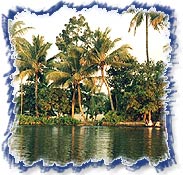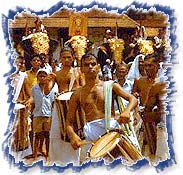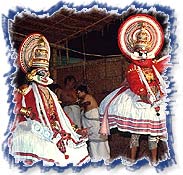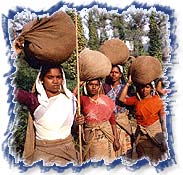Sandwiched between the Lakshwadeep Sea and
the Western Ghats, Kerala is a bustling little green-and-silver,
coconuts-and-water state on the west coast of India. It is bounded by
Karnataka to the north, Tamil Nadu to the east, and the Arabian Sea to the
west. Thiruvananthapuram is its capital.
Every district in Kerala has it's own unique culture and characteristics.
Thiruvananthapuram is known for it's beach- Kovalam, the Sri Padmanabhaswamy
Temple and various museums and palaces; Alappuzha for it's backwaters,
Thrissur, the cultural capital, Kottayam for it's ancient churches,
Kozhikode for it's old world charm and the entrancing Ponmudi or Golden
valley.
Kerala Fact File
| Location : |
Southwestern Tip of India |
| Area |
38,863 Sq. Km |
| Population |
29,011,237 (Census+91) |
| Capital |
Thiruvananthapuram (Trivandrum) |
| Language |
Malayalam, English Is Widely Spoken |
| Religion |
Hinduism, Christianity, Islam |
| Time |
Gmt 5:30 |
| Currency |
Indian Rupee |
| Climate |
Tropical |
| » Summer |
February - May (24 - 33 Dg. C) |
| » Monsoon |
June - September(22 - 28 Dg. C) |
| » Winter |
October - January (22 - 32 Dg. C) |
Capital of Kerala

Though
a bit of a tongue-twister, Thiruvananthapuram - the present official name,
is closer to it's mythological origins. The word ' Thiru ananthapuram' means
the city of Anantha or the abode of the sacred thousand-headed serpent
Anantha, who forms the couch on which reclines Lord Vishnu, the preserver in
the Hindu trinity.
Built on seven hills, it was the capital of the Venad chieftains. The city
has grown as a tourist and commercial centre, with the International airport
becoming the main gateway into Kerala. Being the state capital, it also
throbs with political activity.
History of Kerala
Original inhabitants were animists, followed by the Dravidians. After
Alexander's triumphant sweep over Asia Minor, the ports of Kerala became a
link between the Middle East, the Mediterranean and China.
In 1498, Vasco da Gama made his historic landing on the Malabar Coast. In
1723, the East India Company signed a strategic treaty with King Marthanda
Varma. For a few decades, Hyder Ali and his son -Tipu sultan proved to be a
thorn in the flesh of the British, sweeping down several times into Kerala.
In 1947, it was the turn of the British to pack their bags.
A hundred percent literate people. Worldclass health care system. India's
lowest infant mortality and highest life expectancy rate. The highest
physical quality of life in india. Peaceful and pristine, kerala is also
india's cleanest state.
The People :
Kerala also has considerable ethnic diversity. The Malayali majority belong
to the Dravidian group (local race) of early Indian peoples.
There is a small population of descendants of Indo-European migrants from
the north. Certain hill tribes exhibit affinities with the Negrito peoples
of Southeast Asia. Most Keralites are Hindus, but there are also large
Christian and Islamic, and lesser Jain and Jewish, minorities.
The official language is Malayalam. A long contact with the outside world
has led to an intriguing blend of cultures and given Keralites a
cosmopolitan outlook
 Culture
of Kerala :
Culture
of Kerala :
One aspect of the state's rich cultural heritage is manifest in its
varieties of religious architecture: ancient Hindu temples with copper-clad
roofs, later Islamic mosques with "Malabar gables," and colonial
Portuguese Baroque churches.
Splendid paintings, especially murals, exhibit distinct local traditions
and styles. The land is a flourishing center of the Kathakali dance form.
The state has also a rich theatre tradition: the only surviving Sanskrit
drama, Koottiyattam, is still performed by the Chakkiars of Kerala. Some
principles of the Natya-Shastra are evident in their presentations.
Districts of Kerala
| District (for more info. click the cities below)
|
Area (Sq. Km) |
| » Alleppey
(Alphuzha) |
1414 |
| » Ernakulam
(Cochin) |
2408 |
| » Idukki |
4998 |
| » Kozhikode (Calicut) |
2345 |
| » Kannur |
2997 |
| » Kasargode |
1961 |
| »
Kumarakom |
2204 |
| » Palghat (Palakkad) |
4480 |
| » Pathanamthitta |
2731 |
| » Quilon
(Kollam) |
2579 |
| » Trichur (Trissur) |
3012 |
| » Trivandrum |
2192 |
| » Wayanad |
2132 |
Kerala in General
 1.
Archeological Monuments
1.
Archeological Monuments
Kerala provides some of the archeological monuments, depicting ancient rock
temples, paintings and variety of arts and crafts.
2 . Accommodation & Food
Luxury hotels, medium type hotels as well as budget hotels are available.
Sadhya, the typical kerala feast served on a banana leaf, is a sumptous
spread of rice and more than fourteen vegetable dishes - sambar, rasam,
olan, kaalan, pachadi, kichadi, aviyal, thoran etc., Pickle, crisp pappadam
and banana chips topped off with payasam, the deliciously sweet dessert
cooked in milk.
3. Climate in Kerala
The climate is equable and varies little from season to season. The
temperature normally ranges between 27º and 32º C in the plains
but drops to about 21º C in the highlands.
Winter - 32 to 20 º C. Kerala is strongly buffeted
by both the southwest and northeast monsoons. Rainfall in many parts of the
state exceeds 118 inches. Best season: October to March.
4. Customs and Manners
Courtesy and hospitality is super. The word "namaste" is used to
say good morning, good evening, good bye, or any kind of salutation on
arrival or departure.
 5. Culture of Kerala
5. Culture of Kerala
One aspect of the state's rich cultural heritage is manifest in its
varieties of religious architecture: ancient Hindu temples with copper-clad
roofs, later Islamic mosques with "Malabar gables," and colonial
Portuguese Baroque churches.
Splendid paintings, especially murals, exhibit distinct local traditions
and styles. The land is a flourishing center of the Kathakali dance form.
The state has also a rich theatre tradition: the only surviving Sanskrit
drama, Koottiyattam, is still performed by the Chakkiars of Kerala. Some
principles of the Natya-Shastra are evident in their presentations.
6. Dress
Dhoti and shirt is the common dress for men and Sari for the women. Mundu
and chatta among the christian women, and mundu, rawka and neryiath, is
common among the hindu women. Pants among men and churidar among women are
also common.
7. Dances of Kerala
There are five types of dances in kerala i.e. tribal dances, folk dances,
classical dances, neo classical dances and modern dances.
8. Forests
Forests occupy 28% of the area and timber is an important industry.
9. Fishing and Hiking
Fishing and hiking facilities are available at thekkady wild game sanctury,
neyyar dam and other reserviors and dams.
10. Fairs and Festivals of Kerala
10-day annual festival in January at Sreekandeswaram Temple,
Thiruvananthapuram. In February, is the week-long Nishagandhi Dance
festival; Pooram festival in Thrissur around April-May; Flavor Food
Festival, at the Kanakakunnu Palace grounds, Thiruvananthapuram in May.
Onam Week celebrations, the annual harvest festival of Kerala begins in
August and lasts for 10 days. Another important festival is the annual
Pongala Utsavam, to which only women are allowed at the Attukal Bhagavathy
Temple, Thiruvananthapuram. Therayattam festival is held to propitiate the
gods and demons recognized by the pantheon of the Malayalis.
11. Geography
Kerala lies along a 590 km. Sun drenched, palm fringed, coast line of the
arabian sea from cannanore to thukkalai, (near cape commerin) with sandy
beaches on the west, the sahya mountains of the western ghats on the east,
surrounded by tamil nadu on the south and east and karnataka on the north.
Kerala has three distinct physiographical featurers, the highlands, the
middle lands and the low lands with a total area of about 38863 sq, km. I.e.
1.04% of the total area of India.
12. Handicrafts
Curios and souvenirs, with its ivory, wood and metal carvings and other
handi crafts like jewellery, gold lace, bell metal ware, embroidery cloth,
dolls, fancy articles of coconut shells etc are famous.
13. Languages
Malyalam is the main language. Kannada in the northern districts and tamil
in the eastern and southern districts are common. English and hindi are also
in common use.
 14. Plantation Crops and Spices of Kerala
14. Plantation Crops and Spices of Kerala
Kerala accounts for 10.60 lakhs tons of rice,+91 % of the rubber produced
in india. Kerala is rich in the cultivation of cashewnuts, pepper, coconuts,
cardamom, cinnamon, ginger, mace nut meg. Cloves, tamarind, turmeric etc.
Pepper continues to be the king of kerala spices.
15. Rivers and Backwaters
Kerala is a land of rivers and backwaters. 49 rivers, 46 west flowing and 3
east flowing, cut across kerala with its innunerable tributaries and
branches. These rivers which are small and entirely monsoon fed, turn out to
be rivulets in summer. The backwaters form a specially attractive and
economically valuable feature of kerala. They include, lakes and ocean
inlets which stretch irregularly all along. The biggest backwater is the
vembanad lake which opens out into the arabian sea at cochin port. The other
important back waters are Veli, Kadinakulam, Anjingo, Edava, Madayara,
Paravoor, Asthamudi etc. Some of the most unforgetable sceneries is a back
water journey from alleppey to the ancient port of quilon winding up the
pampa river.
16. Wild Life Game Sancturies
The periyar national park, eravikulam national park, silent valley national
park, thattekad bird sanctuary, wayanad sanctuary, parambikulam sanctuary
and a host of other smaller wild life reserves, make keral attractive to the
tourists.
17. Ayurveda
Ayurveda evolved around 600 bc in india. This system of medicine stresses
on the prevention of body ailments in addition to curing them. Kerala's
equable climate, natural abundance of forests (with a wealth of herbs and
medicinal plants) and the cool monsoon season (june - november) are best
suited for ayurveda's curative and restorative packages. Infact, today,
kerala is the only state in india which practises this system of medicine
with absolute dedication.
18. Sports And Games
All indoor and outdoor games, and sports including hockey, cricket,
football, volley ball, badminton, basket ball, tennis, ring tennis, table
tennis, swimming, wrestling, boxing etc are popular. Golf courses are
available at ernakulam, trivandrum, munnar and peerumedu.
 Occupation
in Kerala :
Occupation
in Kerala :
Agriculture is the state's main economic activity. Plantations of cardamom,
cashew nut, coconuts, coffee, ginger, pepper, rubber, and tea account for 40
percent of the total land.
Commercial poultry farming is well developed. Cottage industries--for
example, the processing of coconut fibre and cashews or weaving--employ
about three-fifths of Kerala's industrial workers. Most of those employed by
larger industrial enterprises are engaged in food and textile processing.


 Though
a bit of a tongue-twister, Thiruvananthapuram - the present official name,
is closer to it's mythological origins. The word ' Thiru ananthapuram' means
the city of Anantha or the abode of the sacred thousand-headed serpent
Anantha, who forms the couch on which reclines Lord Vishnu, the preserver in
the Hindu trinity.
Though
a bit of a tongue-twister, Thiruvananthapuram - the present official name,
is closer to it's mythological origins. The word ' Thiru ananthapuram' means
the city of Anantha or the abode of the sacred thousand-headed serpent
Anantha, who forms the couch on which reclines Lord Vishnu, the preserver in
the Hindu trinity.  Culture
of Kerala :
Culture
of Kerala :  1.
Archeological Monuments
1.
Archeological Monuments 5. Culture of Kerala
5. Culture of Kerala 14. Plantation Crops and Spices of Kerala
14. Plantation Crops and Spices of Kerala Occupation
in Kerala :
Occupation
in Kerala : 